Nursing Leadership and Management Report: Health Deficiencies Analysis
VerifiedAdded on 2019/11/25
|21
|6598
|153
Report
AI Summary
This report examines the state of nursing leadership and management in Victorian hospitals, based on a review highlighting deficiencies in safety and quality. It identifies inconsistencies in healthcare practice, including a lack of consistent excellence across facilities, and the inaccessibility of critical information for clinicians. The report also addresses the immaturity of the safety and quality monitoring system within the Department of Health, emphasizing the need for a more robust framework to detect and address issues such as preventable deaths and poor clinical governance. It connects these deficiencies to the National Safety and Quality Health Service (NSQHS) standards, specifically addressing governance for safety and quality, incident management, and patient identification. The analysis underscores the importance of data utilization, incident reporting, and a proactive approach to patient safety and quality improvement in healthcare settings, as well as the need for a strong leadership and management framework.
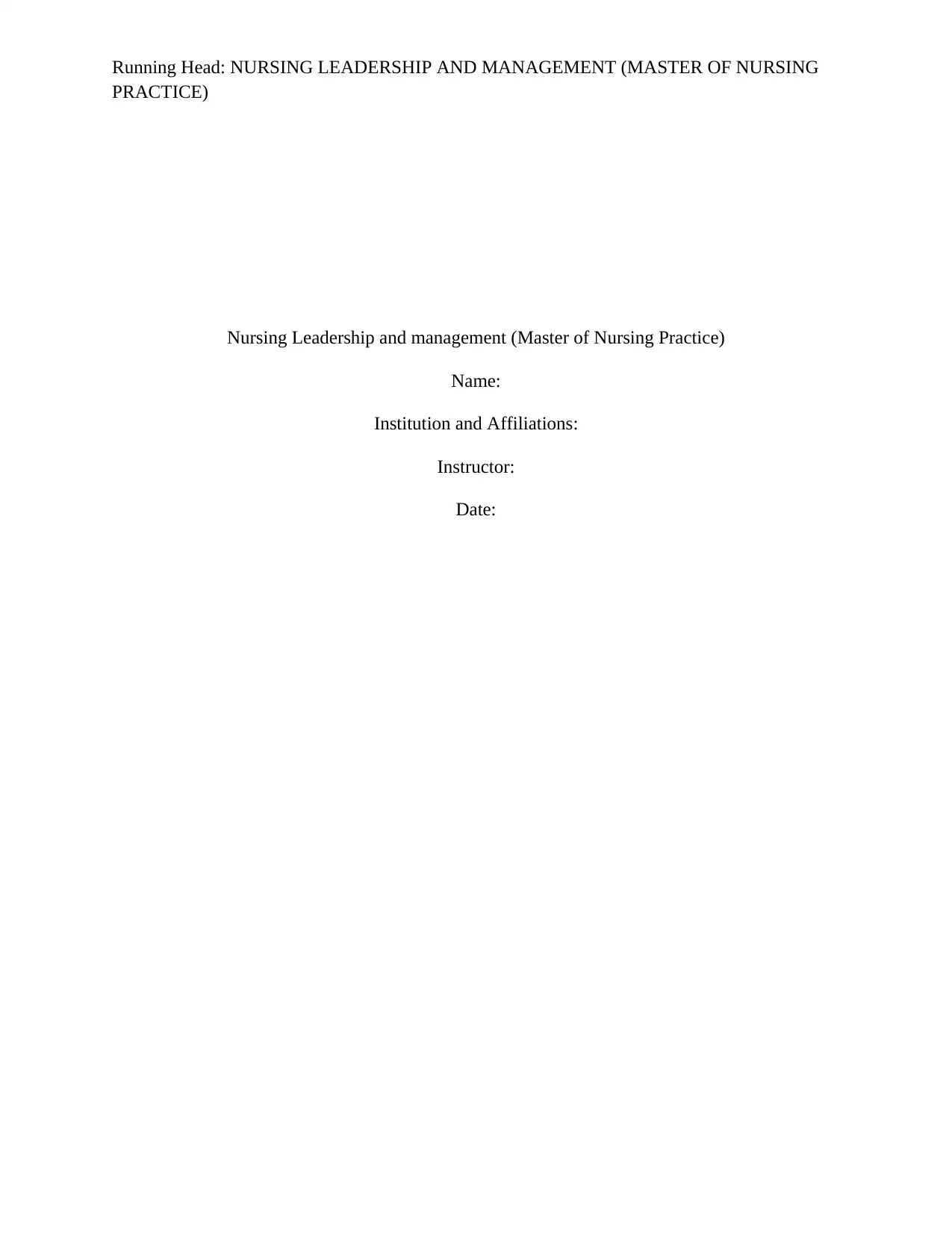
Running Head: NURSING LEADERSHIP AND MANAGEMENT (MASTER OF NURSING
PRACTICE)
Nursing Leadership and management (Master of Nursing Practice)
Name:
Institution and Affiliations:
Instructor:
Date:
PRACTICE)
Nursing Leadership and management (Master of Nursing Practice)
Name:
Institution and Affiliations:
Instructor:
Date:
Paraphrase This Document
Need a fresh take? Get an instant paraphrase of this document with our AI Paraphraser
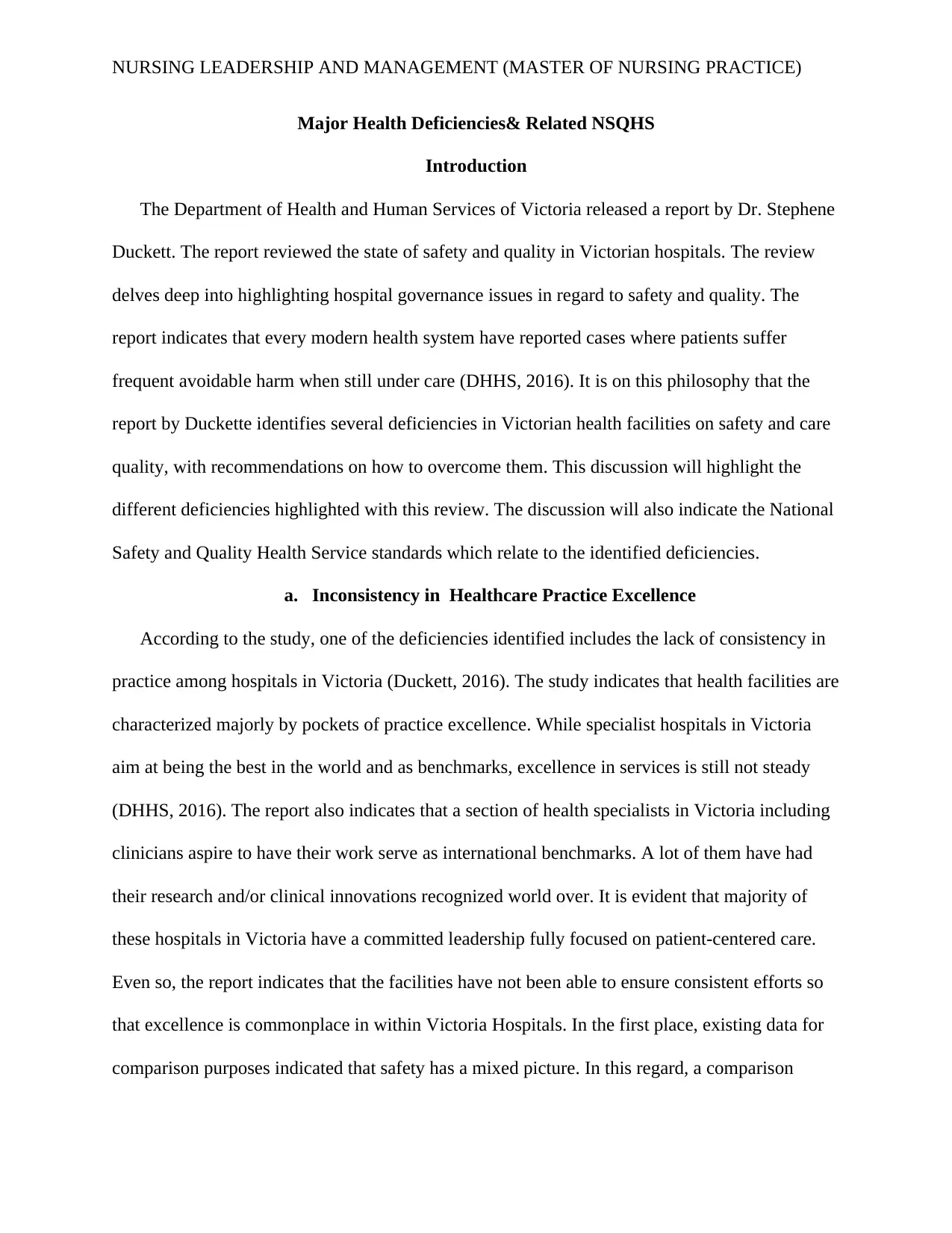
NURSING LEADERSHIP AND MANAGEMENT (MASTER OF NURSING PRACTICE)
Major Health Deficiencies& Related NSQHS
Introduction
The Department of Health and Human Services of Victoria released a report by Dr. Stephene
Duckett. The report reviewed the state of safety and quality in Victorian hospitals. The review
delves deep into highlighting hospital governance issues in regard to safety and quality. The
report indicates that every modern health system have reported cases where patients suffer
frequent avoidable harm when still under care (DHHS, 2016). It is on this philosophy that the
report by Duckette identifies several deficiencies in Victorian health facilities on safety and care
quality, with recommendations on how to overcome them. This discussion will highlight the
different deficiencies highlighted with this review. The discussion will also indicate the National
Safety and Quality Health Service standards which relate to the identified deficiencies.
a. Inconsistency in Healthcare Practice Excellence
According to the study, one of the deficiencies identified includes the lack of consistency in
practice among hospitals in Victoria (Duckett, 2016). The study indicates that health facilities are
characterized majorly by pockets of practice excellence. While specialist hospitals in Victoria
aim at being the best in the world and as benchmarks, excellence in services is still not steady
(DHHS, 2016). The report also indicates that a section of health specialists in Victoria including
clinicians aspire to have their work serve as international benchmarks. A lot of them have had
their research and/or clinical innovations recognized world over. It is evident that majority of
these hospitals in Victoria have a committed leadership fully focused on patient-centered care.
Even so, the report indicates that the facilities have not been able to ensure consistent efforts so
that excellence is commonplace in within Victoria Hospitals. In the first place, existing data for
comparison purposes indicated that safety has a mixed picture. In this regard, a comparison
Major Health Deficiencies& Related NSQHS
Introduction
The Department of Health and Human Services of Victoria released a report by Dr. Stephene
Duckett. The report reviewed the state of safety and quality in Victorian hospitals. The review
delves deep into highlighting hospital governance issues in regard to safety and quality. The
report indicates that every modern health system have reported cases where patients suffer
frequent avoidable harm when still under care (DHHS, 2016). It is on this philosophy that the
report by Duckette identifies several deficiencies in Victorian health facilities on safety and care
quality, with recommendations on how to overcome them. This discussion will highlight the
different deficiencies highlighted with this review. The discussion will also indicate the National
Safety and Quality Health Service standards which relate to the identified deficiencies.
a. Inconsistency in Healthcare Practice Excellence
According to the study, one of the deficiencies identified includes the lack of consistency in
practice among hospitals in Victoria (Duckett, 2016). The study indicates that health facilities are
characterized majorly by pockets of practice excellence. While specialist hospitals in Victoria
aim at being the best in the world and as benchmarks, excellence in services is still not steady
(DHHS, 2016). The report also indicates that a section of health specialists in Victoria including
clinicians aspire to have their work serve as international benchmarks. A lot of them have had
their research and/or clinical innovations recognized world over. It is evident that majority of
these hospitals in Victoria have a committed leadership fully focused on patient-centered care.
Even so, the report indicates that the facilities have not been able to ensure consistent efforts so
that excellence is commonplace in within Victoria Hospitals. In the first place, existing data for
comparison purposes indicated that safety has a mixed picture. In this regard, a comparison
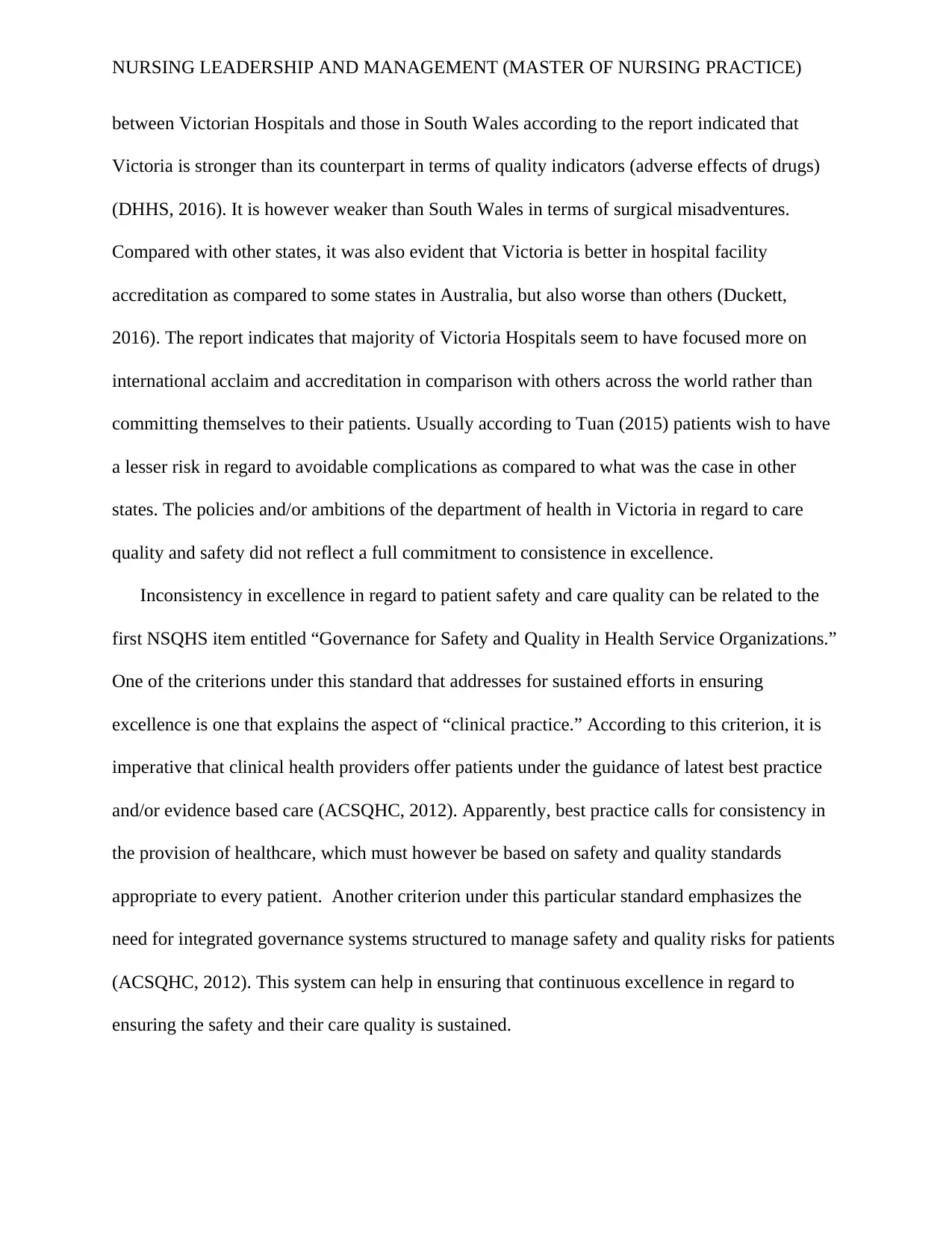
NURSING LEADERSHIP AND MANAGEMENT (MASTER OF NURSING PRACTICE)
between Victorian Hospitals and those in South Wales according to the report indicated that
Victoria is stronger than its counterpart in terms of quality indicators (adverse effects of drugs)
(DHHS, 2016). It is however weaker than South Wales in terms of surgical misadventures.
Compared with other states, it was also evident that Victoria is better in hospital facility
accreditation as compared to some states in Australia, but also worse than others (Duckett,
2016). The report indicates that majority of Victoria Hospitals seem to have focused more on
international acclaim and accreditation in comparison with others across the world rather than
committing themselves to their patients. Usually according to Tuan (2015) patients wish to have
a lesser risk in regard to avoidable complications as compared to what was the case in other
states. The policies and/or ambitions of the department of health in Victoria in regard to care
quality and safety did not reflect a full commitment to consistence in excellence.
Inconsistency in excellence in regard to patient safety and care quality can be related to the
first NSQHS item entitled “Governance for Safety and Quality in Health Service Organizations.”
One of the criterions under this standard that addresses for sustained efforts in ensuring
excellence is one that explains the aspect of “clinical practice.” According to this criterion, it is
imperative that clinical health providers offer patients under the guidance of latest best practice
and/or evidence based care (ACSQHC, 2012). Apparently, best practice calls for consistency in
the provision of healthcare, which must however be based on safety and quality standards
appropriate to every patient. Another criterion under this particular standard emphasizes the
need for integrated governance systems structured to manage safety and quality risks for patients
(ACSQHC, 2012). This system can help in ensuring that continuous excellence in regard to
ensuring the safety and their care quality is sustained.
between Victorian Hospitals and those in South Wales according to the report indicated that
Victoria is stronger than its counterpart in terms of quality indicators (adverse effects of drugs)
(DHHS, 2016). It is however weaker than South Wales in terms of surgical misadventures.
Compared with other states, it was also evident that Victoria is better in hospital facility
accreditation as compared to some states in Australia, but also worse than others (Duckett,
2016). The report indicates that majority of Victoria Hospitals seem to have focused more on
international acclaim and accreditation in comparison with others across the world rather than
committing themselves to their patients. Usually according to Tuan (2015) patients wish to have
a lesser risk in regard to avoidable complications as compared to what was the case in other
states. The policies and/or ambitions of the department of health in Victoria in regard to care
quality and safety did not reflect a full commitment to consistence in excellence.
Inconsistency in excellence in regard to patient safety and care quality can be related to the
first NSQHS item entitled “Governance for Safety and Quality in Health Service Organizations.”
One of the criterions under this standard that addresses for sustained efforts in ensuring
excellence is one that explains the aspect of “clinical practice.” According to this criterion, it is
imperative that clinical health providers offer patients under the guidance of latest best practice
and/or evidence based care (ACSQHC, 2012). Apparently, best practice calls for consistency in
the provision of healthcare, which must however be based on safety and quality standards
appropriate to every patient. Another criterion under this particular standard emphasizes the
need for integrated governance systems structured to manage safety and quality risks for patients
(ACSQHC, 2012). This system can help in ensuring that continuous excellence in regard to
ensuring the safety and their care quality is sustained.
⊘ This is a preview!⊘
Do you want full access?
Subscribe today to unlock all pages.

Trusted by 1+ million students worldwide
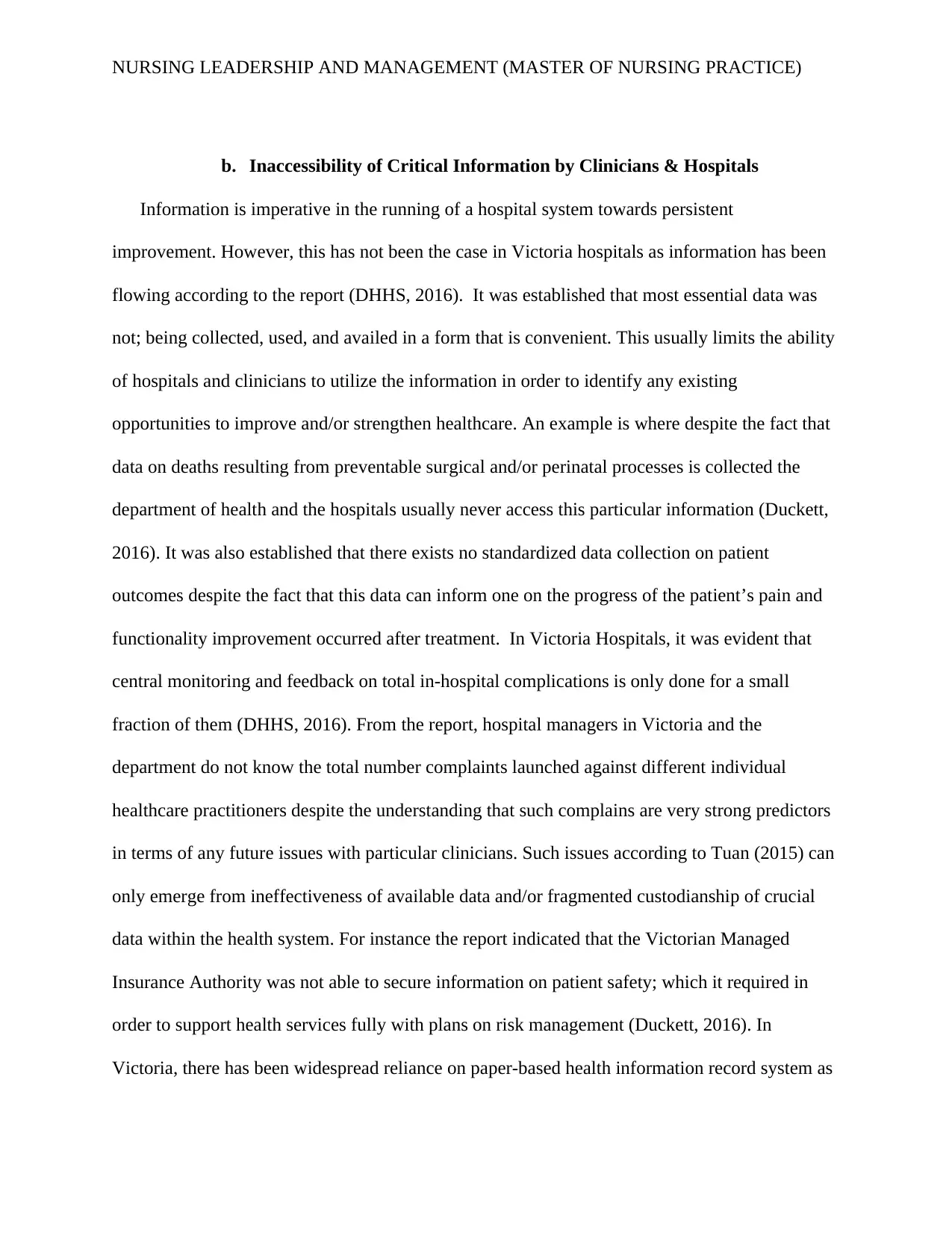
NURSING LEADERSHIP AND MANAGEMENT (MASTER OF NURSING PRACTICE)
b. Inaccessibility of Critical Information by Clinicians & Hospitals
Information is imperative in the running of a hospital system towards persistent
improvement. However, this has not been the case in Victoria hospitals as information has been
flowing according to the report (DHHS, 2016). It was established that most essential data was
not; being collected, used, and availed in a form that is convenient. This usually limits the ability
of hospitals and clinicians to utilize the information in order to identify any existing
opportunities to improve and/or strengthen healthcare. An example is where despite the fact that
data on deaths resulting from preventable surgical and/or perinatal processes is collected the
department of health and the hospitals usually never access this particular information (Duckett,
2016). It was also established that there exists no standardized data collection on patient
outcomes despite the fact that this data can inform one on the progress of the patient’s pain and
functionality improvement occurred after treatment. In Victoria Hospitals, it was evident that
central monitoring and feedback on total in-hospital complications is only done for a small
fraction of them (DHHS, 2016). From the report, hospital managers in Victoria and the
department do not know the total number complaints launched against different individual
healthcare practitioners despite the understanding that such complains are very strong predictors
in terms of any future issues with particular clinicians. Such issues according to Tuan (2015) can
only emerge from ineffectiveness of available data and/or fragmented custodianship of crucial
data within the health system. For instance the report indicated that the Victorian Managed
Insurance Authority was not able to secure information on patient safety; which it required in
order to support health services fully with plans on risk management (Duckett, 2016). In
Victoria, there has been widespread reliance on paper-based health information record system as
b. Inaccessibility of Critical Information by Clinicians & Hospitals
Information is imperative in the running of a hospital system towards persistent
improvement. However, this has not been the case in Victoria hospitals as information has been
flowing according to the report (DHHS, 2016). It was established that most essential data was
not; being collected, used, and availed in a form that is convenient. This usually limits the ability
of hospitals and clinicians to utilize the information in order to identify any existing
opportunities to improve and/or strengthen healthcare. An example is where despite the fact that
data on deaths resulting from preventable surgical and/or perinatal processes is collected the
department of health and the hospitals usually never access this particular information (Duckett,
2016). It was also established that there exists no standardized data collection on patient
outcomes despite the fact that this data can inform one on the progress of the patient’s pain and
functionality improvement occurred after treatment. In Victoria Hospitals, it was evident that
central monitoring and feedback on total in-hospital complications is only done for a small
fraction of them (DHHS, 2016). From the report, hospital managers in Victoria and the
department do not know the total number complaints launched against different individual
healthcare practitioners despite the understanding that such complains are very strong predictors
in terms of any future issues with particular clinicians. Such issues according to Tuan (2015) can
only emerge from ineffectiveness of available data and/or fragmented custodianship of crucial
data within the health system. For instance the report indicated that the Victorian Managed
Insurance Authority was not able to secure information on patient safety; which it required in
order to support health services fully with plans on risk management (Duckett, 2016). In
Victoria, there has been widespread reliance on paper-based health information record system as
Paraphrase This Document
Need a fresh take? Get an instant paraphrase of this document with our AI Paraphraser
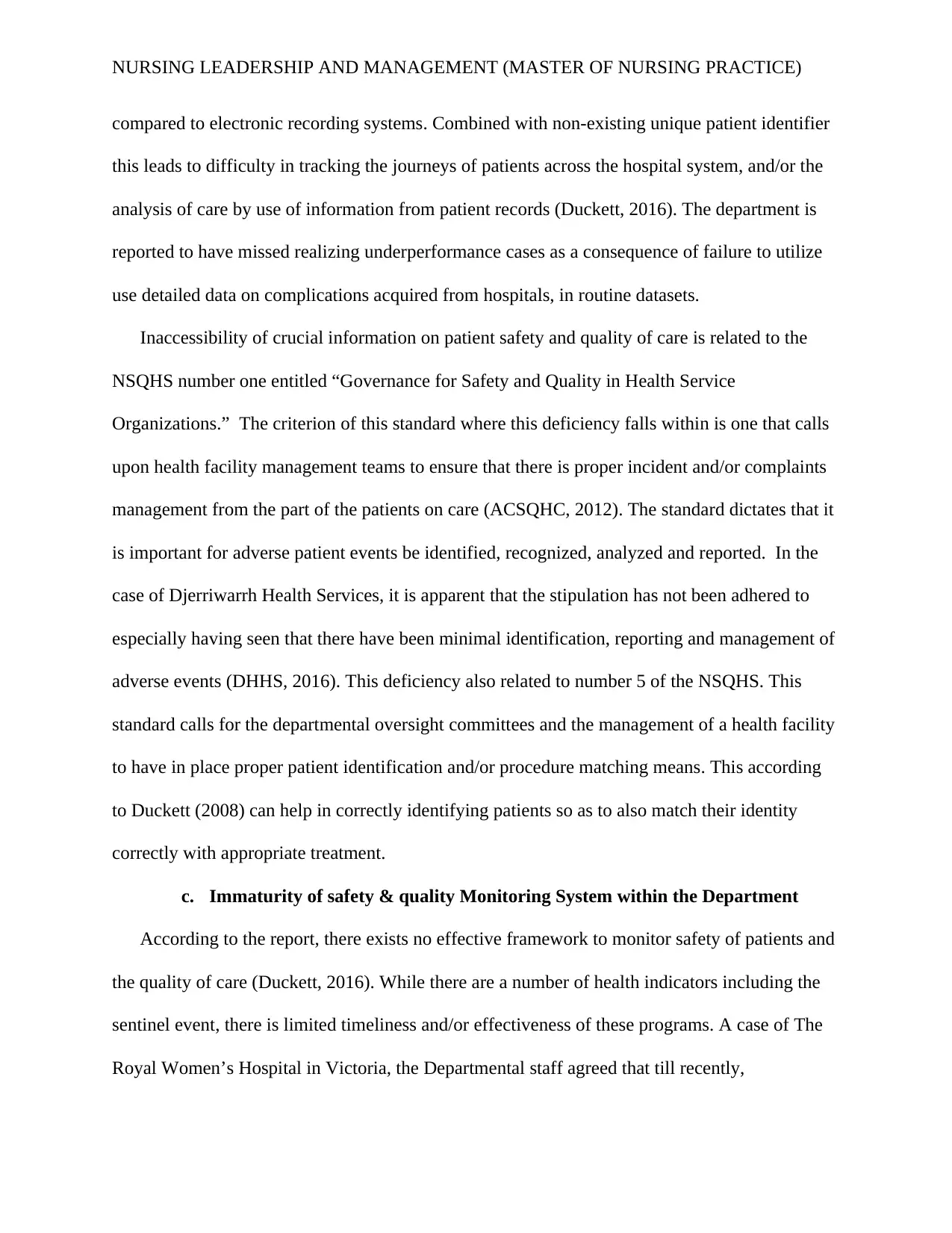
NURSING LEADERSHIP AND MANAGEMENT (MASTER OF NURSING PRACTICE)
compared to electronic recording systems. Combined with non-existing unique patient identifier
this leads to difficulty in tracking the journeys of patients across the hospital system, and/or the
analysis of care by use of information from patient records (Duckett, 2016). The department is
reported to have missed realizing underperformance cases as a consequence of failure to utilize
use detailed data on complications acquired from hospitals, in routine datasets.
Inaccessibility of crucial information on patient safety and quality of care is related to the
NSQHS number one entitled “Governance for Safety and Quality in Health Service
Organizations.” The criterion of this standard where this deficiency falls within is one that calls
upon health facility management teams to ensure that there is proper incident and/or complaints
management from the part of the patients on care (ACSQHC, 2012). The standard dictates that it
is important for adverse patient events be identified, recognized, analyzed and reported. In the
case of Djerriwarrh Health Services, it is apparent that the stipulation has not been adhered to
especially having seen that there have been minimal identification, reporting and management of
adverse events (DHHS, 2016). This deficiency also related to number 5 of the NSQHS. This
standard calls for the departmental oversight committees and the management of a health facility
to have in place proper patient identification and/or procedure matching means. This according
to Duckett (2008) can help in correctly identifying patients so as to also match their identity
correctly with appropriate treatment.
c. Immaturity of safety & quality Monitoring System within the Department
According to the report, there exists no effective framework to monitor safety of patients and
the quality of care (Duckett, 2016). While there are a number of health indicators including the
sentinel event, there is limited timeliness and/or effectiveness of these programs. A case of The
Royal Women’s Hospital in Victoria, the Departmental staff agreed that till recently,
compared to electronic recording systems. Combined with non-existing unique patient identifier
this leads to difficulty in tracking the journeys of patients across the hospital system, and/or the
analysis of care by use of information from patient records (Duckett, 2016). The department is
reported to have missed realizing underperformance cases as a consequence of failure to utilize
use detailed data on complications acquired from hospitals, in routine datasets.
Inaccessibility of crucial information on patient safety and quality of care is related to the
NSQHS number one entitled “Governance for Safety and Quality in Health Service
Organizations.” The criterion of this standard where this deficiency falls within is one that calls
upon health facility management teams to ensure that there is proper incident and/or complaints
management from the part of the patients on care (ACSQHC, 2012). The standard dictates that it
is important for adverse patient events be identified, recognized, analyzed and reported. In the
case of Djerriwarrh Health Services, it is apparent that the stipulation has not been adhered to
especially having seen that there have been minimal identification, reporting and management of
adverse events (DHHS, 2016). This deficiency also related to number 5 of the NSQHS. This
standard calls for the departmental oversight committees and the management of a health facility
to have in place proper patient identification and/or procedure matching means. This according
to Duckett (2008) can help in correctly identifying patients so as to also match their identity
correctly with appropriate treatment.
c. Immaturity of safety & quality Monitoring System within the Department
According to the report, there exists no effective framework to monitor safety of patients and
the quality of care (Duckett, 2016). While there are a number of health indicators including the
sentinel event, there is limited timeliness and/or effectiveness of these programs. A case of The
Royal Women’s Hospital in Victoria, the Departmental staff agreed that till recently,
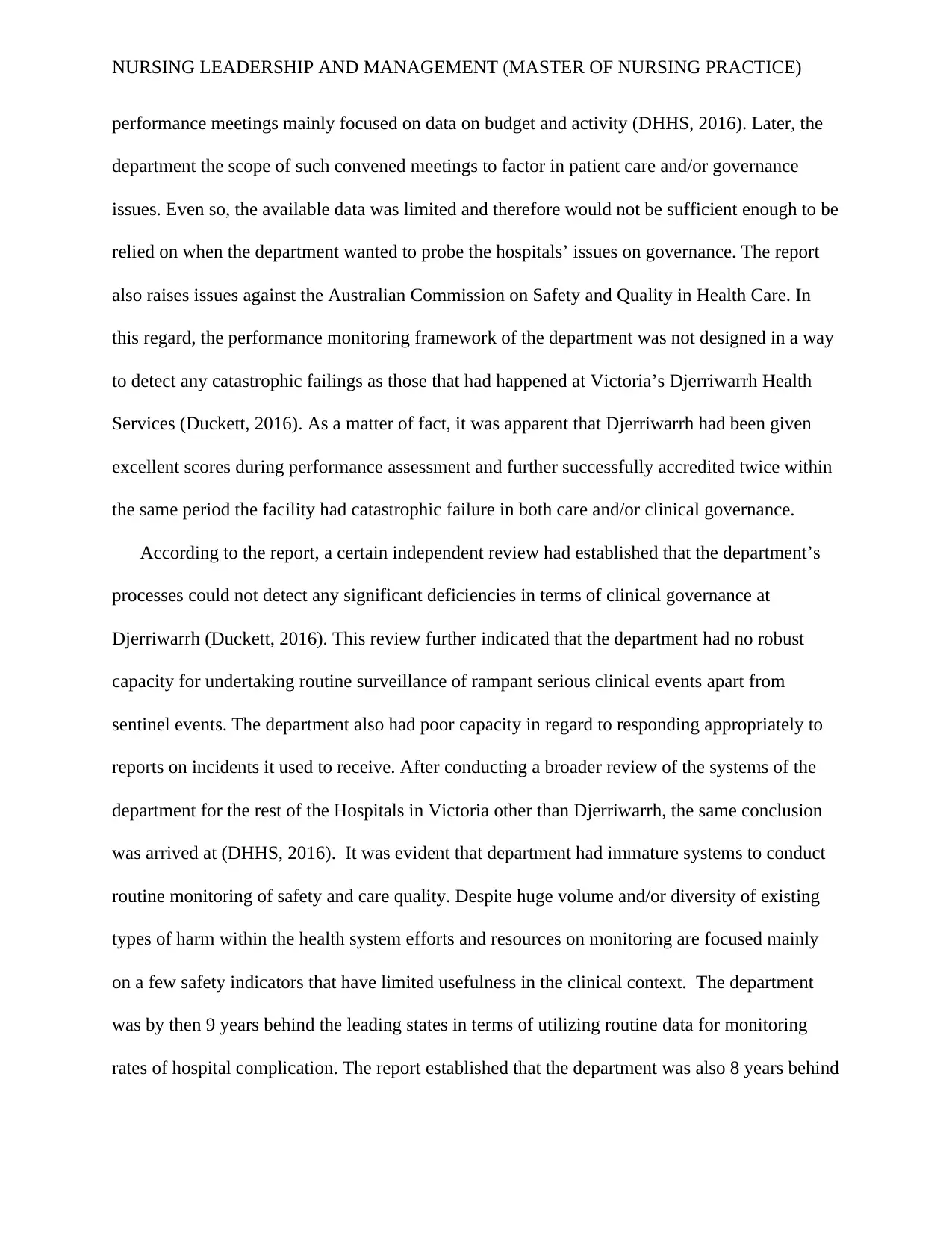
NURSING LEADERSHIP AND MANAGEMENT (MASTER OF NURSING PRACTICE)
performance meetings mainly focused on data on budget and activity (DHHS, 2016). Later, the
department the scope of such convened meetings to factor in patient care and/or governance
issues. Even so, the available data was limited and therefore would not be sufficient enough to be
relied on when the department wanted to probe the hospitals’ issues on governance. The report
also raises issues against the Australian Commission on Safety and Quality in Health Care. In
this regard, the performance monitoring framework of the department was not designed in a way
to detect any catastrophic failings as those that had happened at Victoria’s Djerriwarrh Health
Services (Duckett, 2016). As a matter of fact, it was apparent that Djerriwarrh had been given
excellent scores during performance assessment and further successfully accredited twice within
the same period the facility had catastrophic failure in both care and/or clinical governance.
According to the report, a certain independent review had established that the department’s
processes could not detect any significant deficiencies in terms of clinical governance at
Djerriwarrh (Duckett, 2016). This review further indicated that the department had no robust
capacity for undertaking routine surveillance of rampant serious clinical events apart from
sentinel events. The department also had poor capacity in regard to responding appropriately to
reports on incidents it used to receive. After conducting a broader review of the systems of the
department for the rest of the Hospitals in Victoria other than Djerriwarrh, the same conclusion
was arrived at (DHHS, 2016). It was evident that department had immature systems to conduct
routine monitoring of safety and care quality. Despite huge volume and/or diversity of existing
types of harm within the health system efforts and resources on monitoring are focused mainly
on a few safety indicators that have limited usefulness in the clinical context. The department
was by then 9 years behind the leading states in terms of utilizing routine data for monitoring
rates of hospital complication. The report established that the department was also 8 years behind
performance meetings mainly focused on data on budget and activity (DHHS, 2016). Later, the
department the scope of such convened meetings to factor in patient care and/or governance
issues. Even so, the available data was limited and therefore would not be sufficient enough to be
relied on when the department wanted to probe the hospitals’ issues on governance. The report
also raises issues against the Australian Commission on Safety and Quality in Health Care. In
this regard, the performance monitoring framework of the department was not designed in a way
to detect any catastrophic failings as those that had happened at Victoria’s Djerriwarrh Health
Services (Duckett, 2016). As a matter of fact, it was apparent that Djerriwarrh had been given
excellent scores during performance assessment and further successfully accredited twice within
the same period the facility had catastrophic failure in both care and/or clinical governance.
According to the report, a certain independent review had established that the department’s
processes could not detect any significant deficiencies in terms of clinical governance at
Djerriwarrh (Duckett, 2016). This review further indicated that the department had no robust
capacity for undertaking routine surveillance of rampant serious clinical events apart from
sentinel events. The department also had poor capacity in regard to responding appropriately to
reports on incidents it used to receive. After conducting a broader review of the systems of the
department for the rest of the Hospitals in Victoria other than Djerriwarrh, the same conclusion
was arrived at (DHHS, 2016). It was evident that department had immature systems to conduct
routine monitoring of safety and care quality. Despite huge volume and/or diversity of existing
types of harm within the health system efforts and resources on monitoring are focused mainly
on a few safety indicators that have limited usefulness in the clinical context. The department
was by then 9 years behind the leading states in terms of utilizing routine data for monitoring
rates of hospital complication. The report established that the department was also 8 years behind
⊘ This is a preview!⊘
Do you want full access?
Subscribe today to unlock all pages.

Trusted by 1+ million students worldwide
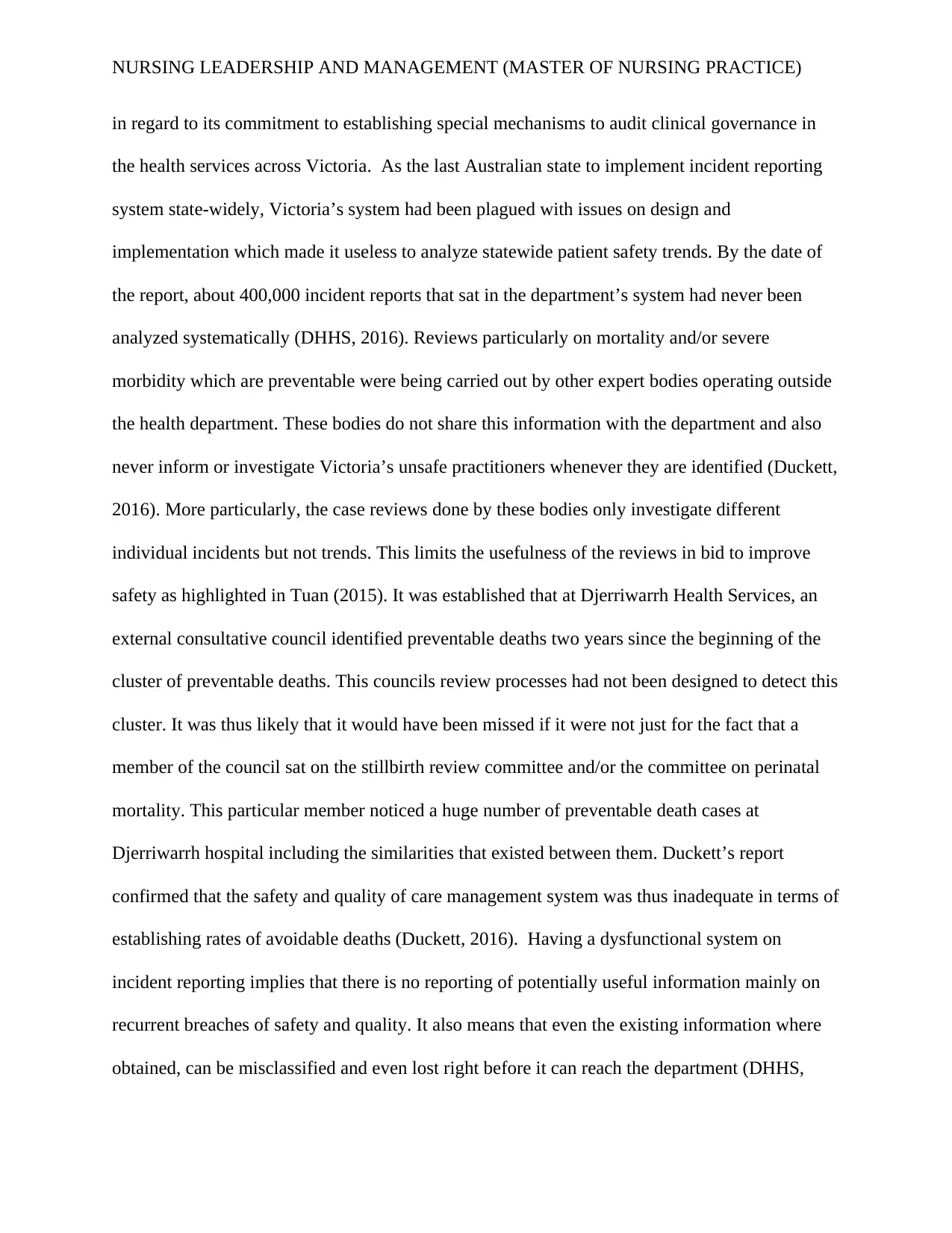
NURSING LEADERSHIP AND MANAGEMENT (MASTER OF NURSING PRACTICE)
in regard to its commitment to establishing special mechanisms to audit clinical governance in
the health services across Victoria. As the last Australian state to implement incident reporting
system state-widely, Victoria’s system had been plagued with issues on design and
implementation which made it useless to analyze statewide patient safety trends. By the date of
the report, about 400,000 incident reports that sat in the department’s system had never been
analyzed systematically (DHHS, 2016). Reviews particularly on mortality and/or severe
morbidity which are preventable were being carried out by other expert bodies operating outside
the health department. These bodies do not share this information with the department and also
never inform or investigate Victoria’s unsafe practitioners whenever they are identified (Duckett,
2016). More particularly, the case reviews done by these bodies only investigate different
individual incidents but not trends. This limits the usefulness of the reviews in bid to improve
safety as highlighted in Tuan (2015). It was established that at Djerriwarrh Health Services, an
external consultative council identified preventable deaths two years since the beginning of the
cluster of preventable deaths. This councils review processes had not been designed to detect this
cluster. It was thus likely that it would have been missed if it were not just for the fact that a
member of the council sat on the stillbirth review committee and/or the committee on perinatal
mortality. This particular member noticed a huge number of preventable death cases at
Djerriwarrh hospital including the similarities that existed between them. Duckett’s report
confirmed that the safety and quality of care management system was thus inadequate in terms of
establishing rates of avoidable deaths (Duckett, 2016). Having a dysfunctional system on
incident reporting implies that there is no reporting of potentially useful information mainly on
recurrent breaches of safety and quality. It also means that even the existing information where
obtained, can be misclassified and even lost right before it can reach the department (DHHS,
in regard to its commitment to establishing special mechanisms to audit clinical governance in
the health services across Victoria. As the last Australian state to implement incident reporting
system state-widely, Victoria’s system had been plagued with issues on design and
implementation which made it useless to analyze statewide patient safety trends. By the date of
the report, about 400,000 incident reports that sat in the department’s system had never been
analyzed systematically (DHHS, 2016). Reviews particularly on mortality and/or severe
morbidity which are preventable were being carried out by other expert bodies operating outside
the health department. These bodies do not share this information with the department and also
never inform or investigate Victoria’s unsafe practitioners whenever they are identified (Duckett,
2016). More particularly, the case reviews done by these bodies only investigate different
individual incidents but not trends. This limits the usefulness of the reviews in bid to improve
safety as highlighted in Tuan (2015). It was established that at Djerriwarrh Health Services, an
external consultative council identified preventable deaths two years since the beginning of the
cluster of preventable deaths. This councils review processes had not been designed to detect this
cluster. It was thus likely that it would have been missed if it were not just for the fact that a
member of the council sat on the stillbirth review committee and/or the committee on perinatal
mortality. This particular member noticed a huge number of preventable death cases at
Djerriwarrh hospital including the similarities that existed between them. Duckett’s report
confirmed that the safety and quality of care management system was thus inadequate in terms of
establishing rates of avoidable deaths (Duckett, 2016). Having a dysfunctional system on
incident reporting implies that there is no reporting of potentially useful information mainly on
recurrent breaches of safety and quality. It also means that even the existing information where
obtained, can be misclassified and even lost right before it can reach the department (DHHS,
Paraphrase This Document
Need a fresh take? Get an instant paraphrase of this document with our AI Paraphraser
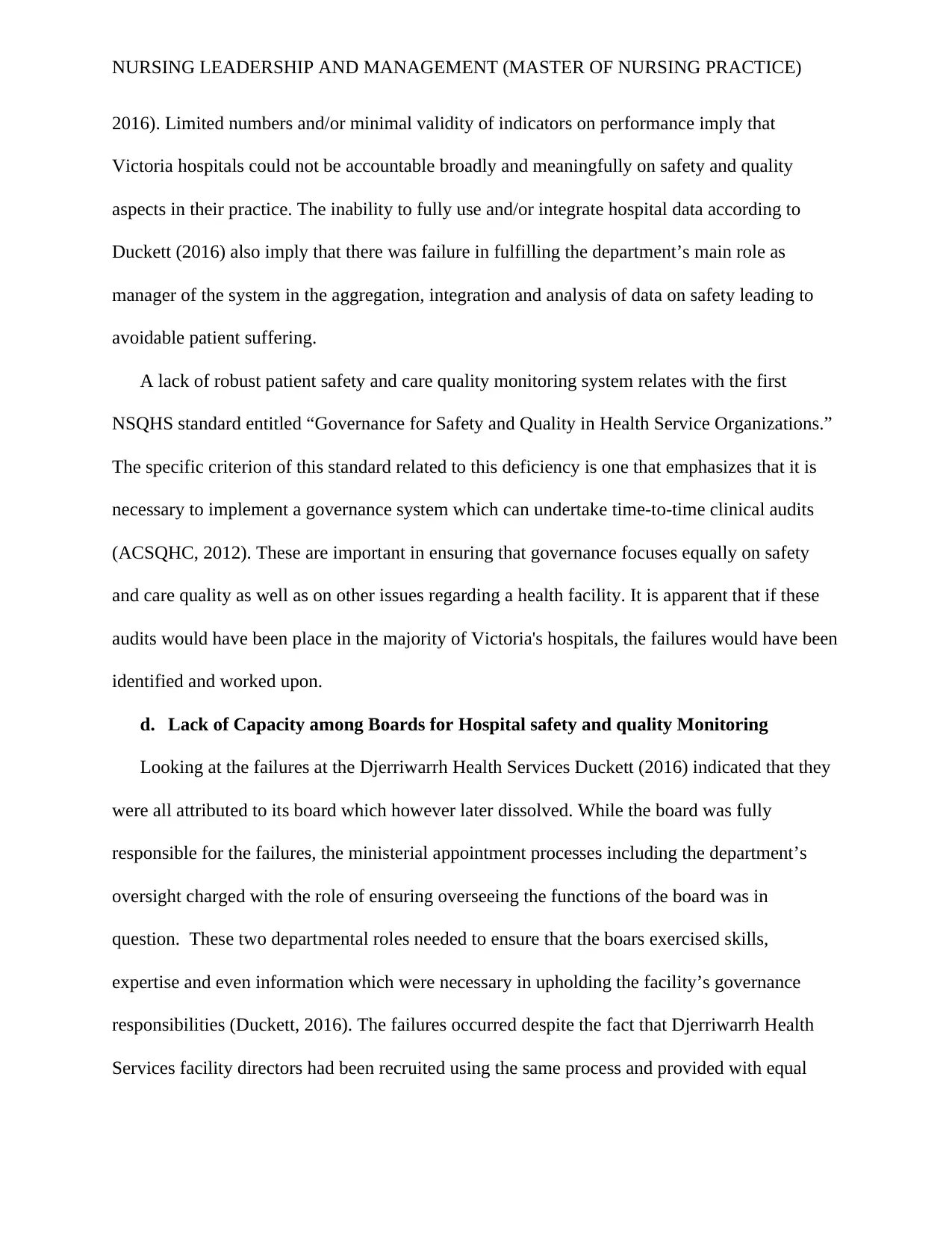
NURSING LEADERSHIP AND MANAGEMENT (MASTER OF NURSING PRACTICE)
2016). Limited numbers and/or minimal validity of indicators on performance imply that
Victoria hospitals could not be accountable broadly and meaningfully on safety and quality
aspects in their practice. The inability to fully use and/or integrate hospital data according to
Duckett (2016) also imply that there was failure in fulfilling the department’s main role as
manager of the system in the aggregation, integration and analysis of data on safety leading to
avoidable patient suffering.
A lack of robust patient safety and care quality monitoring system relates with the first
NSQHS standard entitled “Governance for Safety and Quality in Health Service Organizations.”
The specific criterion of this standard related to this deficiency is one that emphasizes that it is
necessary to implement a governance system which can undertake time-to-time clinical audits
(ACSQHC, 2012). These are important in ensuring that governance focuses equally on safety
and care quality as well as on other issues regarding a health facility. It is apparent that if these
audits would have been place in the majority of Victoria's hospitals, the failures would have been
identified and worked upon.
d. Lack of Capacity among Boards for Hospital safety and quality Monitoring
Looking at the failures at the Djerriwarrh Health Services Duckett (2016) indicated that they
were all attributed to its board which however later dissolved. While the board was fully
responsible for the failures, the ministerial appointment processes including the department’s
oversight charged with the role of ensuring overseeing the functions of the board was in
question. These two departmental roles needed to ensure that the boars exercised skills,
expertise and even information which were necessary in upholding the facility’s governance
responsibilities (Duckett, 2016). The failures occurred despite the fact that Djerriwarrh Health
Services facility directors had been recruited using the same process and provided with equal
2016). Limited numbers and/or minimal validity of indicators on performance imply that
Victoria hospitals could not be accountable broadly and meaningfully on safety and quality
aspects in their practice. The inability to fully use and/or integrate hospital data according to
Duckett (2016) also imply that there was failure in fulfilling the department’s main role as
manager of the system in the aggregation, integration and analysis of data on safety leading to
avoidable patient suffering.
A lack of robust patient safety and care quality monitoring system relates with the first
NSQHS standard entitled “Governance for Safety and Quality in Health Service Organizations.”
The specific criterion of this standard related to this deficiency is one that emphasizes that it is
necessary to implement a governance system which can undertake time-to-time clinical audits
(ACSQHC, 2012). These are important in ensuring that governance focuses equally on safety
and care quality as well as on other issues regarding a health facility. It is apparent that if these
audits would have been place in the majority of Victoria's hospitals, the failures would have been
identified and worked upon.
d. Lack of Capacity among Boards for Hospital safety and quality Monitoring
Looking at the failures at the Djerriwarrh Health Services Duckett (2016) indicated that they
were all attributed to its board which however later dissolved. While the board was fully
responsible for the failures, the ministerial appointment processes including the department’s
oversight charged with the role of ensuring overseeing the functions of the board was in
question. These two departmental roles needed to ensure that the boars exercised skills,
expertise and even information which were necessary in upholding the facility’s governance
responsibilities (Duckett, 2016). The failures occurred despite the fact that Djerriwarrh Health
Services facility directors had been recruited using the same process and provided with equal
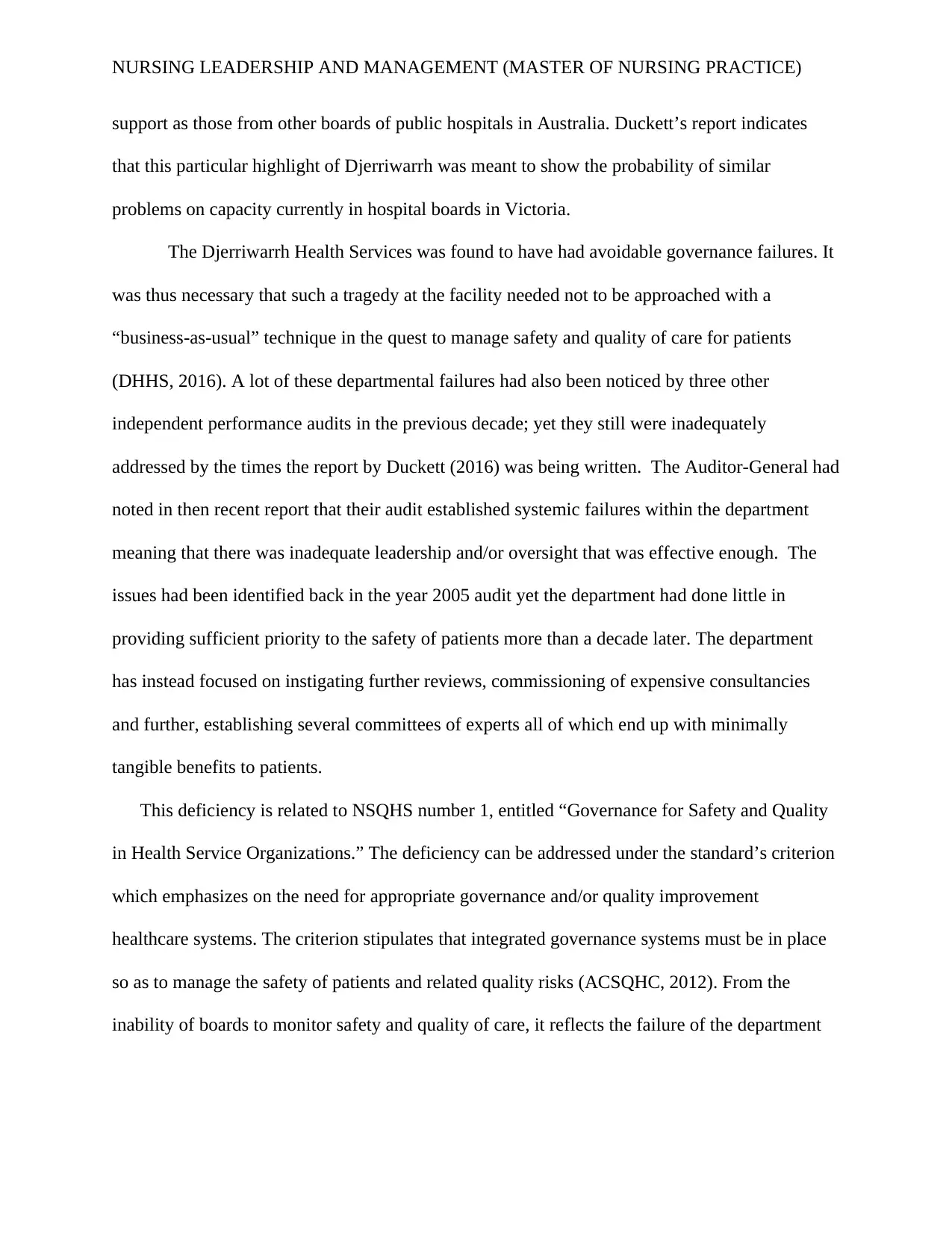
NURSING LEADERSHIP AND MANAGEMENT (MASTER OF NURSING PRACTICE)
support as those from other boards of public hospitals in Australia. Duckett’s report indicates
that this particular highlight of Djerriwarrh was meant to show the probability of similar
problems on capacity currently in hospital boards in Victoria.
The Djerriwarrh Health Services was found to have had avoidable governance failures. It
was thus necessary that such a tragedy at the facility needed not to be approached with a
“business-as-usual” technique in the quest to manage safety and quality of care for patients
(DHHS, 2016). A lot of these departmental failures had also been noticed by three other
independent performance audits in the previous decade; yet they still were inadequately
addressed by the times the report by Duckett (2016) was being written. The Auditor-General had
noted in then recent report that their audit established systemic failures within the department
meaning that there was inadequate leadership and/or oversight that was effective enough. The
issues had been identified back in the year 2005 audit yet the department had done little in
providing sufficient priority to the safety of patients more than a decade later. The department
has instead focused on instigating further reviews, commissioning of expensive consultancies
and further, establishing several committees of experts all of which end up with minimally
tangible benefits to patients.
This deficiency is related to NSQHS number 1, entitled “Governance for Safety and Quality
in Health Service Organizations.” The deficiency can be addressed under the standard’s criterion
which emphasizes on the need for appropriate governance and/or quality improvement
healthcare systems. The criterion stipulates that integrated governance systems must be in place
so as to manage the safety of patients and related quality risks (ACSQHC, 2012). From the
inability of boards to monitor safety and quality of care, it reflects the failure of the department
support as those from other boards of public hospitals in Australia. Duckett’s report indicates
that this particular highlight of Djerriwarrh was meant to show the probability of similar
problems on capacity currently in hospital boards in Victoria.
The Djerriwarrh Health Services was found to have had avoidable governance failures. It
was thus necessary that such a tragedy at the facility needed not to be approached with a
“business-as-usual” technique in the quest to manage safety and quality of care for patients
(DHHS, 2016). A lot of these departmental failures had also been noticed by three other
independent performance audits in the previous decade; yet they still were inadequately
addressed by the times the report by Duckett (2016) was being written. The Auditor-General had
noted in then recent report that their audit established systemic failures within the department
meaning that there was inadequate leadership and/or oversight that was effective enough. The
issues had been identified back in the year 2005 audit yet the department had done little in
providing sufficient priority to the safety of patients more than a decade later. The department
has instead focused on instigating further reviews, commissioning of expensive consultancies
and further, establishing several committees of experts all of which end up with minimally
tangible benefits to patients.
This deficiency is related to NSQHS number 1, entitled “Governance for Safety and Quality
in Health Service Organizations.” The deficiency can be addressed under the standard’s criterion
which emphasizes on the need for appropriate governance and/or quality improvement
healthcare systems. The criterion stipulates that integrated governance systems must be in place
so as to manage the safety of patients and related quality risks (ACSQHC, 2012). From the
inability of boards to monitor safety and quality of care, it reflects the failure of the department
⊘ This is a preview!⊘
Do you want full access?
Subscribe today to unlock all pages.

Trusted by 1+ million students worldwide
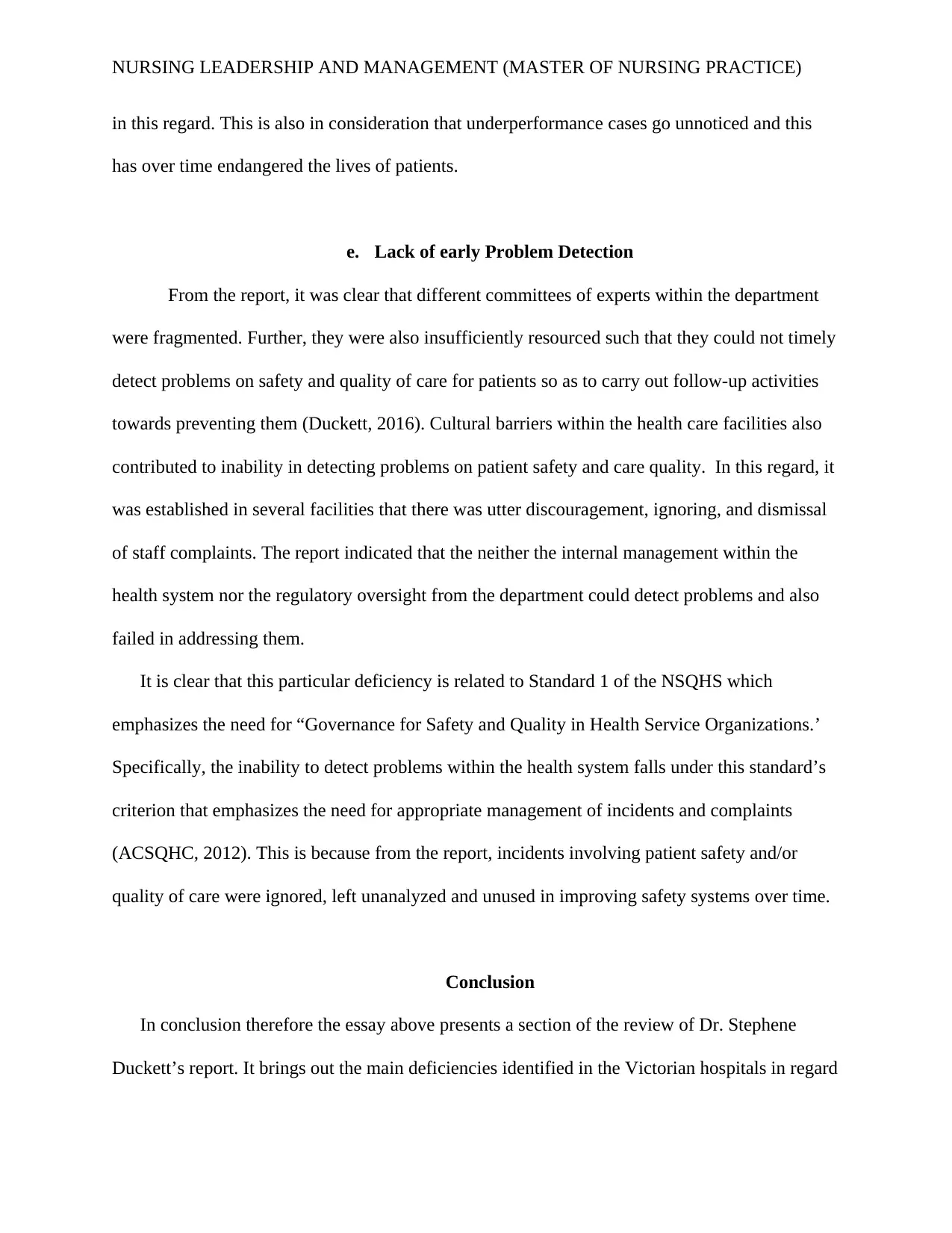
NURSING LEADERSHIP AND MANAGEMENT (MASTER OF NURSING PRACTICE)
in this regard. This is also in consideration that underperformance cases go unnoticed and this
has over time endangered the lives of patients.
e. Lack of early Problem Detection
From the report, it was clear that different committees of experts within the department
were fragmented. Further, they were also insufficiently resourced such that they could not timely
detect problems on safety and quality of care for patients so as to carry out follow-up activities
towards preventing them (Duckett, 2016). Cultural barriers within the health care facilities also
contributed to inability in detecting problems on patient safety and care quality. In this regard, it
was established in several facilities that there was utter discouragement, ignoring, and dismissal
of staff complaints. The report indicated that the neither the internal management within the
health system nor the regulatory oversight from the department could detect problems and also
failed in addressing them.
It is clear that this particular deficiency is related to Standard 1 of the NSQHS which
emphasizes the need for “Governance for Safety and Quality in Health Service Organizations.’
Specifically, the inability to detect problems within the health system falls under this standard’s
criterion that emphasizes the need for appropriate management of incidents and complaints
(ACSQHC, 2012). This is because from the report, incidents involving patient safety and/or
quality of care were ignored, left unanalyzed and unused in improving safety systems over time.
Conclusion
In conclusion therefore the essay above presents a section of the review of Dr. Stephene
Duckett’s report. It brings out the main deficiencies identified in the Victorian hospitals in regard
in this regard. This is also in consideration that underperformance cases go unnoticed and this
has over time endangered the lives of patients.
e. Lack of early Problem Detection
From the report, it was clear that different committees of experts within the department
were fragmented. Further, they were also insufficiently resourced such that they could not timely
detect problems on safety and quality of care for patients so as to carry out follow-up activities
towards preventing them (Duckett, 2016). Cultural barriers within the health care facilities also
contributed to inability in detecting problems on patient safety and care quality. In this regard, it
was established in several facilities that there was utter discouragement, ignoring, and dismissal
of staff complaints. The report indicated that the neither the internal management within the
health system nor the regulatory oversight from the department could detect problems and also
failed in addressing them.
It is clear that this particular deficiency is related to Standard 1 of the NSQHS which
emphasizes the need for “Governance for Safety and Quality in Health Service Organizations.’
Specifically, the inability to detect problems within the health system falls under this standard’s
criterion that emphasizes the need for appropriate management of incidents and complaints
(ACSQHC, 2012). This is because from the report, incidents involving patient safety and/or
quality of care were ignored, left unanalyzed and unused in improving safety systems over time.
Conclusion
In conclusion therefore the essay above presents a section of the review of Dr. Stephene
Duckett’s report. It brings out the main deficiencies identified in the Victorian hospitals in regard
Paraphrase This Document
Need a fresh take? Get an instant paraphrase of this document with our AI Paraphraser
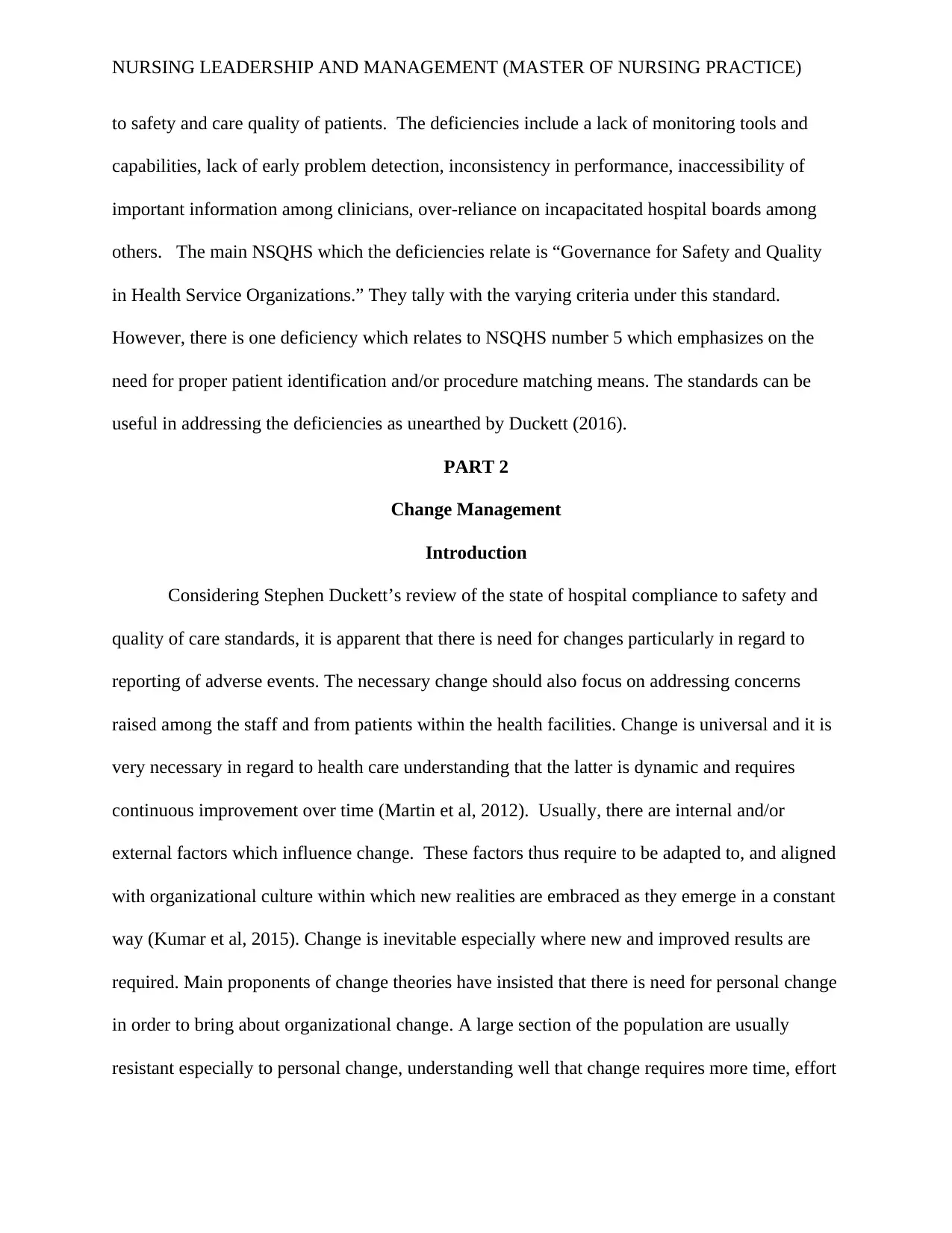
NURSING LEADERSHIP AND MANAGEMENT (MASTER OF NURSING PRACTICE)
to safety and care quality of patients. The deficiencies include a lack of monitoring tools and
capabilities, lack of early problem detection, inconsistency in performance, inaccessibility of
important information among clinicians, over-reliance on incapacitated hospital boards among
others. The main NSQHS which the deficiencies relate is “Governance for Safety and Quality
in Health Service Organizations.” They tally with the varying criteria under this standard.
However, there is one deficiency which relates to NSQHS number 5 which emphasizes on the
need for proper patient identification and/or procedure matching means. The standards can be
useful in addressing the deficiencies as unearthed by Duckett (2016).
PART 2
Change Management
Introduction
Considering Stephen Duckett’s review of the state of hospital compliance to safety and
quality of care standards, it is apparent that there is need for changes particularly in regard to
reporting of adverse events. The necessary change should also focus on addressing concerns
raised among the staff and from patients within the health facilities. Change is universal and it is
very necessary in regard to health care understanding that the latter is dynamic and requires
continuous improvement over time (Martin et al, 2012). Usually, there are internal and/or
external factors which influence change. These factors thus require to be adapted to, and aligned
with organizational culture within which new realities are embraced as they emerge in a constant
way (Kumar et al, 2015). Change is inevitable especially where new and improved results are
required. Main proponents of change theories have insisted that there is need for personal change
in order to bring about organizational change. A large section of the population are usually
resistant especially to personal change, understanding well that change requires more time, effort
to safety and care quality of patients. The deficiencies include a lack of monitoring tools and
capabilities, lack of early problem detection, inconsistency in performance, inaccessibility of
important information among clinicians, over-reliance on incapacitated hospital boards among
others. The main NSQHS which the deficiencies relate is “Governance for Safety and Quality
in Health Service Organizations.” They tally with the varying criteria under this standard.
However, there is one deficiency which relates to NSQHS number 5 which emphasizes on the
need for proper patient identification and/or procedure matching means. The standards can be
useful in addressing the deficiencies as unearthed by Duckett (2016).
PART 2
Change Management
Introduction
Considering Stephen Duckett’s review of the state of hospital compliance to safety and
quality of care standards, it is apparent that there is need for changes particularly in regard to
reporting of adverse events. The necessary change should also focus on addressing concerns
raised among the staff and from patients within the health facilities. Change is universal and it is
very necessary in regard to health care understanding that the latter is dynamic and requires
continuous improvement over time (Martin et al, 2012). Usually, there are internal and/or
external factors which influence change. These factors thus require to be adapted to, and aligned
with organizational culture within which new realities are embraced as they emerge in a constant
way (Kumar et al, 2015). Change is inevitable especially where new and improved results are
required. Main proponents of change theories have insisted that there is need for personal change
in order to bring about organizational change. A large section of the population are usually
resistant especially to personal change, understanding well that change requires more time, effort
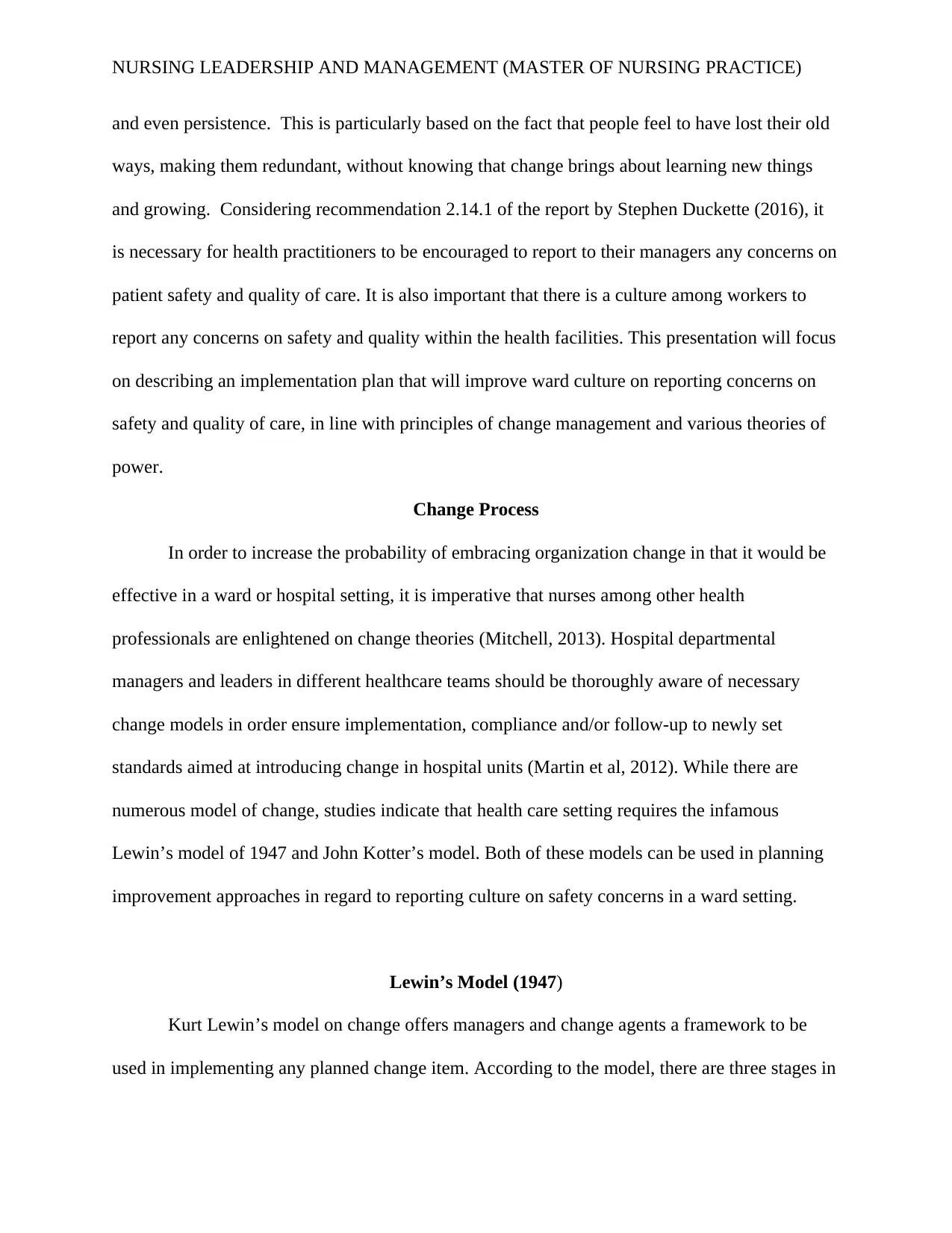
NURSING LEADERSHIP AND MANAGEMENT (MASTER OF NURSING PRACTICE)
and even persistence. This is particularly based on the fact that people feel to have lost their old
ways, making them redundant, without knowing that change brings about learning new things
and growing. Considering recommendation 2.14.1 of the report by Stephen Duckette (2016), it
is necessary for health practitioners to be encouraged to report to their managers any concerns on
patient safety and quality of care. It is also important that there is a culture among workers to
report any concerns on safety and quality within the health facilities. This presentation will focus
on describing an implementation plan that will improve ward culture on reporting concerns on
safety and quality of care, in line with principles of change management and various theories of
power.
Change Process
In order to increase the probability of embracing organization change in that it would be
effective in a ward or hospital setting, it is imperative that nurses among other health
professionals are enlightened on change theories (Mitchell, 2013). Hospital departmental
managers and leaders in different healthcare teams should be thoroughly aware of necessary
change models in order ensure implementation, compliance and/or follow-up to newly set
standards aimed at introducing change in hospital units (Martin et al, 2012). While there are
numerous model of change, studies indicate that health care setting requires the infamous
Lewin’s model of 1947 and John Kotter’s model. Both of these models can be used in planning
improvement approaches in regard to reporting culture on safety concerns in a ward setting.
Lewin’s Model (1947)
Kurt Lewin’s model on change offers managers and change agents a framework to be
used in implementing any planned change item. According to the model, there are three stages in
and even persistence. This is particularly based on the fact that people feel to have lost their old
ways, making them redundant, without knowing that change brings about learning new things
and growing. Considering recommendation 2.14.1 of the report by Stephen Duckette (2016), it
is necessary for health practitioners to be encouraged to report to their managers any concerns on
patient safety and quality of care. It is also important that there is a culture among workers to
report any concerns on safety and quality within the health facilities. This presentation will focus
on describing an implementation plan that will improve ward culture on reporting concerns on
safety and quality of care, in line with principles of change management and various theories of
power.
Change Process
In order to increase the probability of embracing organization change in that it would be
effective in a ward or hospital setting, it is imperative that nurses among other health
professionals are enlightened on change theories (Mitchell, 2013). Hospital departmental
managers and leaders in different healthcare teams should be thoroughly aware of necessary
change models in order ensure implementation, compliance and/or follow-up to newly set
standards aimed at introducing change in hospital units (Martin et al, 2012). While there are
numerous model of change, studies indicate that health care setting requires the infamous
Lewin’s model of 1947 and John Kotter’s model. Both of these models can be used in planning
improvement approaches in regard to reporting culture on safety concerns in a ward setting.
Lewin’s Model (1947)
Kurt Lewin’s model on change offers managers and change agents a framework to be
used in implementing any planned change item. According to the model, there are three stages in
⊘ This is a preview!⊘
Do you want full access?
Subscribe today to unlock all pages.

Trusted by 1+ million students worldwide
1 out of 21
Related Documents
Your All-in-One AI-Powered Toolkit for Academic Success.
+13062052269
info@desklib.com
Available 24*7 on WhatsApp / Email
![[object Object]](/_next/static/media/star-bottom.7253800d.svg)
Unlock your academic potential
Copyright © 2020–2025 A2Z Services. All Rights Reserved. Developed and managed by ZUCOL.





